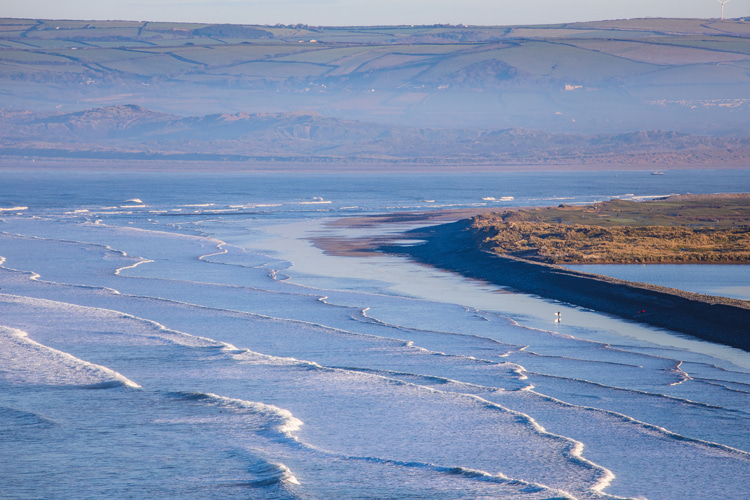
The road to becoming a complete surfer is a long one. But if there’s one skill that could set you apart, it’s surf forecasting and basic meteorology.
Here’s the good news.
You don’t need a PhD in oceanography to guess how big or good the waves will be tomorrow.
With just a bit of wind data, an interactive map, and a few easy equations born from one of the most trusted wave prediction methods in history – the Sverdrup-Munk-Bretschneider (SMB) method or modification – you can do it old-school style.
The idea is to look at a purple fetch on Windy.com, measure its distance from your favorite surf break, and guess the wave height you might get when you paddle out.
And, trust us, you don’t even need to be a math geek to estimate it quite well.

The Story Behind the SMB Method
Back in the 1940s, World War II strategists and planners faced a serious problem: how to predict ocean conditions for landing operations when no wave buoys or satellites existed.
The science of surf forecasting had yet to be invented, yet, interestingly, they ended up laying its foundations.
There is actually an amazing book titled “Surf Forecasting For Invasions During World War II” that details the story of the wave predictions for D-Day, when thousands of Allied troops disembarked on the Normandy beaches.
The SMB is a set of equations created by Harald Sverdrup, Walter Munk, and Hans-Jürgen Bretschneider.
The formulae connected wind speed, fetch (the distance the wind blows over open water), and duration (how long it blows) to wave height and period.
In other words, based on these empirical calculations, several fields of study, from naval operations to surf forecasting and coastal management, can determine the size (and quality) of the waves at the end of their travel, i.e., on coastlines.

The Three Variables
According to SMB, wind-driven waves can exist in three “growth stages”:
- Fetch-limited: the wind blows over a small or enclosed area, like a lake or bay. Waves stop growing once they run out of space;
- Duration-limited: the wind blows for only a short time, long enough to agitate the water, not long enough to build big waves;
- Fully arisen sea (fully developed sea): the wind has blown strong and long over a large fetch, and the sea has reached its maximum possible wave size for that wind speed;
Each case has its own formula for wave height (H) and wave period (T), too.
The Simplified Equations
Here’s the wave forecaster’s cheat sheet.
Use U in meters per second (m/s), F in meters (m), and t in seconds (s). You can convert the values this way:
- 1 kilometers per hour = 0.2778 meter per s;
- 1 kilometer = 1000 meters;
- 1 hour = 3600 seconds;
1. Fetch-Limited Waves
In this case, wind runs out of ocean before it runs out of time.
H = 0.016 * U * F^0.5
T = 0.285 * F^0.33
Rule of thumb: a long fetch (hundreds of kilometers) means bigger, better-organized waves even if the wind stops before they reach shore.
2. Duration-Limited Waves
Now, this is the case of when the wind blows over enough ocean, but not for long enough.
H = 0.018 * U^1.25 * t^0.75
T = 0.83 * U^0.57 * t^0.37
Here, short-lived wind bursts create small, choppy waves, which could eventually be OK for windsurfing, but not clean enough to have nice surf lines.
3. Fully Arisen Sea
Finally, here’s the equation for when the wind blows long and hard over a vast fetch and the sea maxes out.
H = 0.025 * U^2
T = 0.73 * U
It’s the dream setup for open-ocean swell generation, that is, groundswells.
If you see strong winds (like 60 kilometers per hour or more) blowing for over a day across hundreds of kilometers, you may wax up your surfboard because there’s a swell factory in action.

Don’t Know Which One Applies? Here’s a Trick
In real life, it might be tricky to know if the waves are fetch- or duration-limited, right?
No problem. It’s acceptable if you calculate all three and take the smallest value of wave height H.
The reason is that the ocean naturally limits itself by whichever factor – fetch or duration – is smaller.
For most oceanic situations, fetch is the limiter; for small lakes or short wind bursts, duration is.
A Quick Example: Your Local Surf Spot
Let’s say a wind map shows a 30 kilometers per hour wind (that’s 8.3 m/s) blowing across 200 kilometers of open ocean for several hours.
Using the fetch-limited formula:
H = 0.016 * 8.3 * (200,000)^0.5 = 1.5 m
So, you’ll probably get around head-high surf, give or take, but only if that swell travels toward your coast and the local winds don’t ruin it.
If the wind only blew for an hour or two, plug those numbers into the duration formula, and you’d probably get 0.5 meters or less.
In other words, small wind chop, not surfable lines.
Putting It All Together
The SMB method is a perfect middle ground between raw weather charts and advanced surf forecasts.
It tells surfers how wind speed, fetch, and time interact to shape wave energy before it even reaches your beach.
So next time you see a pressure system spinning across the map, grab your calculator (or just your phone), plug in a few numbers, and get a first-glance read on what the ocean might deliver.
It’s a great math exercise and will definitely surprise you.
Words by Luís MP | Founder of SurferToday.com


Leave a Reply